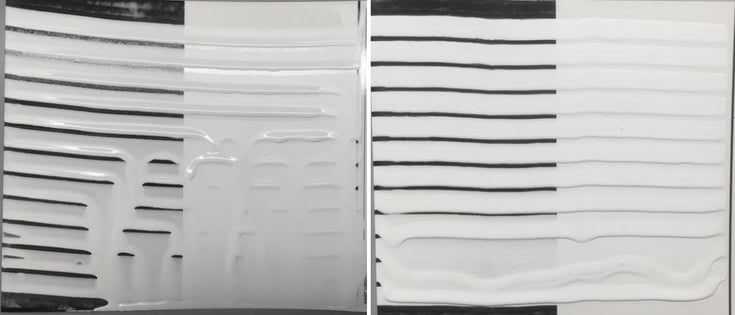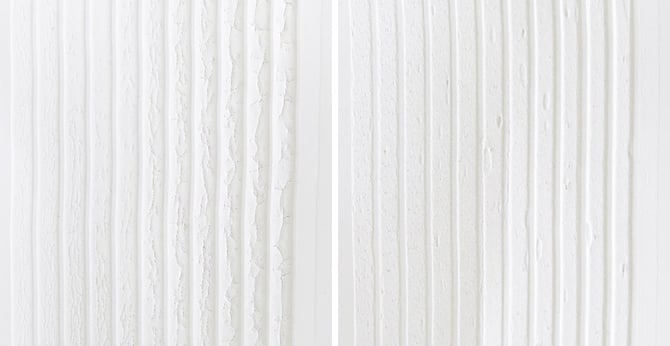
Higher wet film thickness with microfibrillated cellulose
Otto Soidinsalo | March 15, 2022
High-build coatings, also known as ultra high-build (UHB) coatings are paints that are applied in high wet film thickness ranging from 5 Mils to 60 plus Mils. UHB coatings are typically used in situations where long term protection is needed or the material coated is exposed to harsh conditions, ranging from heavy rain to salt water. These coatings are preferably applied in one coat to save cost, especially in more demanding environments, such as in the case of bridges or high buildings.
Typical end uses are for example protective and elastomeric coatings, sanding and edge sealers as well as for flexible wall coatings and flooring. UHB coatings are typically applied either by roller or with conventional HVLP or airless spray equipment.
Challenges
As the target film thickness is significantly higher than in conventional coatings, two aspects generally restrict the applied coatings thickness, sagging and mud cracking. Increasing the wet film thickness generally means that the tendency for sagging will increase as the sagging is mainly driven by the gravitational shear stress. In case sagging is not the limiting factor, then typically mud cracking will occur . As the wet film thickness increases, the tendency for mud cracking increases. The surface of the wet paint will close and the remaining water evaporating will create pressure under the skinned top layer, eventually leading to mud cracking.
Current solutions
The most common way to the avoid mud cracking from taking place is to limit the wet film thickness of the paint. Typically, this is achievable by using high quality paint with higher solid content, often leading to better hiding power. However, if the coating layer thickness is critical for the performance, then additives that reduce mud cracking need to be added. Platy minerals, such as pyrophyllite or mica and acicular wollastonite are often used for this purpose. Although these minerals also provide some thickening, in most cases a secondary low shear thickener is needed for sag control.
Excellent sag resistance without any indication of mud cracking
The unique property of microfibrillated cellulose (MFC) is its ability to increase the low shear viscosity with minimal impact on mid shear (KU) and with no impact on the high shear (ICI). This means that formulators can reach very high wet film thickness without any impact on the mid shear and no fear of sagging. Figure 1 shows the difference between two paints with comparable mid shear (KU) viscosity. The formulation based on MFC has more than 100% higher sag resistance. On the other hand, the insoluble fibrils of MFC impact the mud crack resistance. Figure 2 is a pictorial representation of the impact on mud cracking. The formulation based on MFC shows no cracking at 1,5 mm whereas the reference formulation cracks at 360 µm.

Figure 1. Reference coatings on the left (sagging at 18 Mils / 450 µm)
and formulation with Exilva on the right (sagging at 45 Mils / 1,1 mm)

Figure 2. Reference coatings on the left (mud cracking at 14 Mils / 360 µm)
and formulation with Exilva on the right (pass at 60 Mils / 1,52 mm)
Summary
Microfibrillated cellulose allows the application of high wet film thicknesses without any indication of sagging or mud cracking. In addition, the strong low shear thickening ensures stable formulations and solves any issues regarding settling or syneresis without increasing the mid shear viscosity. The non-stringy nature of microfibrillated cellulose improves sprayability of the paint and results in smoother surfaces and easier applicability.
Written by:
Otto Soidinsalo
Dr. Otto Soidinsalo holds a Ph.D. in organic chemistry from the University of Helsinki. Currently he works as a Technical Application Manager at Borregaard. Before joining Borregaard, Otto was working in various positions in pharma and cellulose derivatives related industries for 8 years, ranging from R&D to product and application development and technical services. Currently Otto is focusing on CASE as well as on paper & packaging applications, especially on barrier coatings. Otto possesses a deep understanding of the natural polymers and their derivatives and their impact on rheology as well as mechanical properties of various applications.
